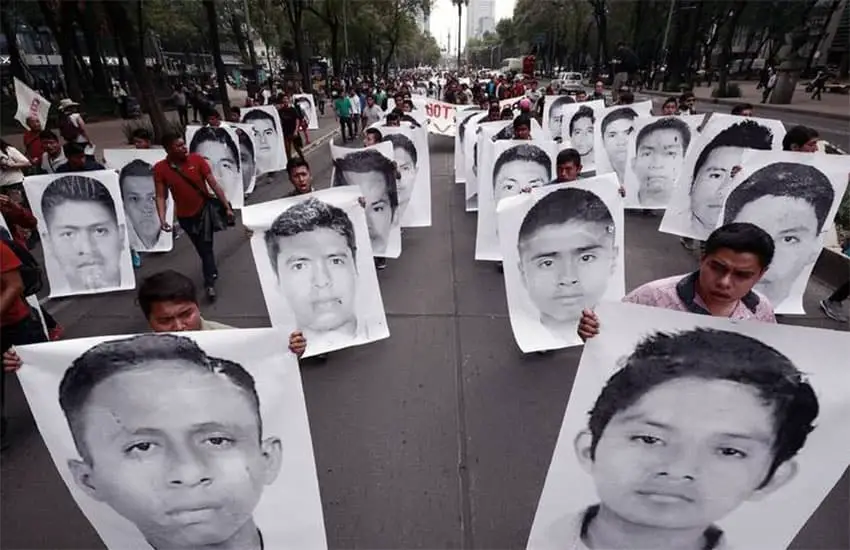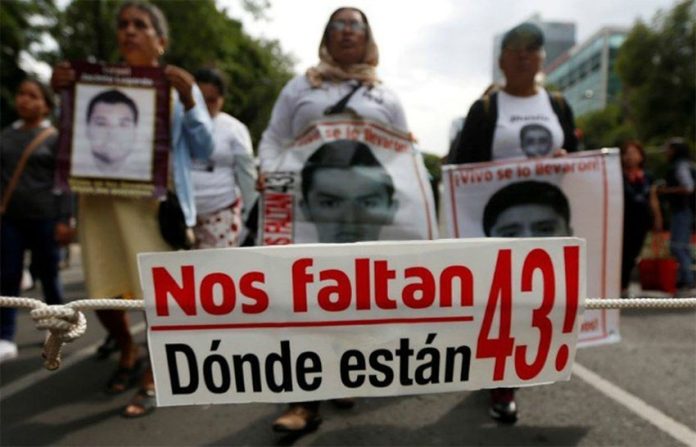The United States is set to close its investigation into crimes allegedly related to the disappearance of 43 students in Iguala, Guerrero, in 2014.
A leader of the Guerreros Unidos crime gang – which allegedly killed the Ayotzinapa rural teacher’s college students – has confessed to transporting drugs from Iguala to Chicago and reached an agreement with the United States government to provide information to the U.S. about the illegal smuggling.
Pablo Vega, who has been in prison in the United States for the past seven years, pleaded guilty in April to transporting drugs to the U.S. in passenger buses, according to the newspaper Milenio, which reviewed official U.S. documents. The details of the agreement he reached with U.S. authorities is classified but it appears likely he will be released from prison as a result of his agreement to collaborate.
José Rodríguez, an associate of Vega who was also a member of the Guerreros Unidos, is currently in negotiations with U.S. authorities and pending an agreement will officially plead guilty to trafficking charges on September 1, Milenio said.
Once that occurs the Ayotzinapa-Iguala case will be officially closed in the United States.
The United States Drug Enforcement Administration (DEA) determined several years ago that the Guerreros Unidos had transported heroin to the United States on passenger buses. The gang transported the heroin in hidden panels on the buses that ran from its territory in Iguala to Aurora, a suburb of Chicago, the DEA established.
By intercepting dozens of messages Vega received on his Blackberry phone, the DEA also concluded that Guerreros Unidos members in the United States were aware of the abduction of the 43 students on September 26, 2014.
The students were on a bus they had commandeered to travel to a protest in Mexico City when they were intercepted and came under attack by Iguala municipal police. Independent experts who investigated the students’ disappearance said that one hypothesis is that the bus on which they were traveling was carrying drugs and would have left for the United States had it not been commandeered. It was allegedly one of five buses carrying drugs that was scheduled to depart for the U.S. on the day the students disappeared.
According to the previous federal government’s official version of events, the students were intercepted by corrupt municipal police who handed them over to the Guerreros Unidos. Gang members then killed the students, burned their bodies in a dump in the municipality of Cocula and disposed of their remains in a nearby river, according to the so-called “historical truth” presented in January 2015.
But the “historical truth” was rejected by the current government, which established a truth commission and launched a new investigation. It hasn’t yet presented its own definitive version of events but is expected to do so soon. The remains of just three of the 43 students have been formally identified. The remains of two of those showed no evidence of fire damage, leading Omar Gómez Trejo, the special prosecutor in charge of the reexamination of the case, to declare that the “historical truth is over.”
In order to disprove the previous theory the current government has been relying heavily on the declarations of a protected witness known only as Juan, Milenio reported this week. The man – a suspected leader of the Guerreros Unidos who says he didn’t participate in the events of September 26 – provided testimony to the federal Attorney General’s Office (FGR) in early 2020 (which was subsequently leaked) that asserted that the army and state police were directly involved in the disappearance of the 43 students.

In a court appearance in May, Juan presented information that added to and clarified his earlier testimony.
He said that the army, Federal Police, Guerrero police and Iguala municipal police all collaborated with the Guerreros Unidos on the night of the students’ disappearance. Juan also said that Jesús Pérez Lagunas, a Guerreros Unidos leader known as “El Güero Mugres” (The Filthy Blondie), issued an order for all the students to be killed.
Milenio noted that authorities had not previously linked Pérez to the disappearance of the students. El Güero Mugres was murdered in 2018.
Juan previously said that three groups of students and suspected hitmen from a rival gang were detained on September 26. One group was taken away by the Guerreros Unidos, another was placed in the custody of state police and the third group was transported to an army base in Guerrero, he said.
Juan said the group taken to the army base was interrogated before being handed over to a cell of the Guerreros Unidos. Some of the students and suspected gang members were already dead at that time, he said.
The witness said the Guerreros Unidos killed those who were still alive and dissolved the bodies of the deceased in acid and caustic soda. Liquid remains were then poured down the drain, he said. Other students and suspected gangsters were allegedly butchered with machetes and axes at a cartel hideout in Iguala before some of their remains were cremated at a funeral home on the outskirts of Iguala.
Ashes were allegedly scattered in various locations, including in the municipality of Cocula, which borders Iguala. All told, 70 or 80 people including the 43 students were killed on September 26 and 27, 2014, Juan told the FGR.
In his new testimony, he asserted that state and federal security officials including former Guerrero security minister Leonardo Octavio Vázquez Pérez, ex-attorney general Iñaki Blanco and an army captain were on the Guerreros Unidos’ payroll and in cahoots with El Güero Mugres. He previously accused Omar Harfuch, Mexico City’s police chief, who was previously a Federal Police coordinator in Guerrero, of being on the gang’s payroll but didn’t mention him in his most recent testimony.
Juan received the information he presented to authorities via radio and text messages and at a meeting on September 30, 2014, with Guerreros Unidos members involved in the crimes, Milenio said.
Although 43 students disappeared, the Guerreros Unidos didn’t think that the case would become such big news, Juan told the court during his appearance at the hearing in May. The case triggered mass protests against the federal government less than two years after former president Enrique Peña Nieto took office, and there was some belief – and a lot of hope – at the time that he could be ousted.
“Fue el estado,” or “It was the state” was a constant refrain at those protests and many, if not most, Mexicans remain convinced that federal security forces were involved in the students’ disappearance.
With reports from Milenio
